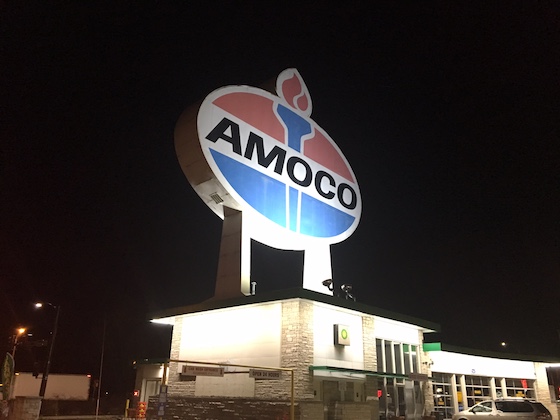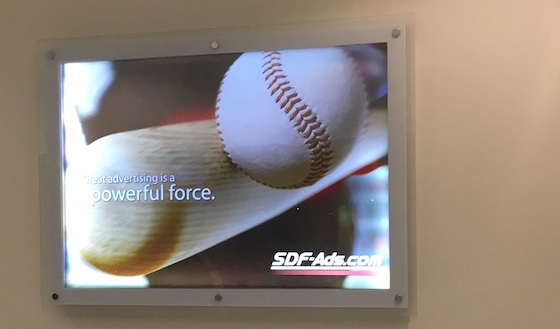Memo From Frank
Valentine’s Day is in a couple weeks, and you’ll need to buy the regular flowers, card and expensive dinner. Although money can’t buy happiness, it can certainly come in handy during such annual events. And having a little extra money can be important the rest of the year, too. What’s attractive about billboard investing is that you can build your portfolio as big or small as you choose – either a few hundred bucks a month or a full replacement of your day job. Billboards make for a great income supplement because they don’t require much time to operate – you only rent the ad space once or twice a year and you only check on them periodically. Learn how a couple old-fashioned wooden billboards can dramatically change your cash flow in 2017.
A Primer On Building And Operating Landmark Signs

This is a photo of the largest gas station sign in the U.S. It’s located in St. Louis and it’s a historic landmark. Landmark signs can be found in all 50 states, and whether or not they become a piece of history, they are always a source of huge profits. So how does a normal sign become a landmark?
Scarcity of location
To make a sign a landmark, scarcity is key. You need a location that makes people think “how did they ever get a sign there?” I once found a city east of Dallas that had a very restrictive ordinance on billboards and, when you consulted the zoning map, you found that there was only one legal location in the entire town. So I sought out that location and cut a deal with the land owner. That’s the type of deal construction that creates a landmark sign.
Massive size
One thing that most – but not all – landmark signs have in common is giant size. They are unique because they are giants. Giant signs may be illegal in many markets, and they are also extremely costly, so I’d suggest you look at two options. One is a wall scape – a vinyl ad hung directly on the side of a masonry building – inside the city limits if the ordinance allows it. The other is taking advantage of that little-known loophole in the Highway Beautification Act that allows signs greater than 660’ from the right-of-way to be outside of the ordinance (but confirm this in your state). This would allow you to take advantage of such roadside objects as water towers and grain elevators – or even giant barns.
Clear visibility
Landmark signs normally have above-average visibility. Of course, this is not much of a challenge if they are naturally big and tall. Nevertheless, if you can find a location that has “curve in the road” visibility or “right in the middle of the skyline” exposure, that’s fantastic. I once owned the sign on the corner of Wilshire and La Brea in Los Angeles. Everybody knew that sign – it was even in the background on a couple movies.
Unique sizes and shapes
Landmark signs don’t feel restricted by conventionality. They are unique and they don’t have to be standardized. One great example is the “waterfall” billboard on Goat Hill in Dallas, where the North Dallas Tollway and Stemmons Freeway meet. This sign met no normal billboard stats – it was irregular sized and had a waterfall rolling down one-third of it. It was built for Pearl Beer, but the waterfall kept going regardless of who advertised on it. I have also seen landmark signs that are round, square, tilted – and everything in-between.
Motion
Some of the true landmark signs move around. Not the whole sign – just a piece. For example, the classic Las Vegas sign where the cowboy moves his arm. This type of motion is nothing more than a motor mounted on the back of the sign, and wired into the lights. The item that moves is cut on a separate panel and bolted on, and sits about a foot above the sign face. Since it is extremely rare to have “motion” on a billboard, it is extremely memorable. However, it may be illegal in your state or municipality, so make sure it’s O.K. before you proceed.
Intense lighting
Some landmark signs have spectacular lighting displays, with neon or flashing lights. The Highway Beautification Act ended flashing lights in most applications, but you can still do some pretty remarkable things with the lighting on a sign. A mixture of standard halogen lighting and some portions in neon has a very unusual effect that gets motorists to look.
Conclusion
Landmark signs are one in a million. But if you own one, it’s an amazing asset. If you have the right mixture of ingredients, you can possibly create a landmark sign – and it is well worth the effort.
Billboard Home Study Course
![]() How to Find a Billboard Location
How to Find a Billboard Location
![]() How to Buy a Billboard
How to Buy a Billboard
![]() How to Build a Billboard
How to Build a Billboard
![]() How to Operate a Billboard
How to Operate a Billboard
![]() How to Rent Ad Space on a Billboard
How to Rent Ad Space on a Billboard
![]() How to Sell a Billboard
How to Sell a Billboard
Get Your Copy Now!
Signs And Storms: What Sometimes Happens And What To Do

This is photo of a sign that was struck by a severe windstorm recently. This is what every sign owner worries about, yet happens very, very rarely. In over a decade of owning over 300 billboards, I only ever had three serious storm incidents. But you still need to know what the risks are and how to recover from them.
Torn vinyl
In the event of high winds, one of the first things to fail is the vinyl ad face. That’s exactly what’s supposed to happen. You are way ahead replacing a vinyl than something structural. When a vinyl gets torn, there’s no way to fix it – the only solution is to replace it. But the first order of business is to get the damaged vinyl picked up before it causes more damage. It it’s hanging from the sign, it can put unnecessary wind force on the sign structure, and should be removed immediately. An even bigger problem can be the anger of the property owner if you leave it laying on the ground. Vinyl is not very heavy, and you can load it into your trunk if you are the first one at the scene.
Loss of panels
Often, in conjunction with the vinyl breaking loose, the sign can lose one or more of the panels that the vinyl wraps around. This is a far bigger problem than simply losing the vinyl. The good news is that it’s not that expensive to put a couple panels back up. Back when signs were hand-painted 25 years ago, losing just one panel would require re-painting the entire ad because you could never match the paint color perfectly. But in today’s vinyl world, the panels are merely there to hold up the vinyl wrap. Again, the key thing to focus on when this happens is where the panels went. You need to make sure they are not laying in the road or on top of something. Although you can’t load them in your car, you can slide them over and set them by the base of the sign.
Bending of structural column(s)
OK, now things are getting worse. The failure of a structural element is very serious. As long as the column does not break, the typical fix is to dig down, have a crane pull the column straight again, and then fill the hole with concrete. Of bigger concern is the potential danger to anything located beneath the sign. You will need to have a sign contractor stabilize the structure until it can be repaired, and you may need to warn the property owner of the danger.
Complete collapse
This is the true disaster scenario. I’ve only ever had it happen one time. The structural columns snap and the whole sign comes crashing down. My sign was an old wooden one that I purchased as a group of signs from a bank. In a wind over 100 mph, the sign just could not handle the force and collapsed. The good news is that it didn’t land on anything, just earth. The sign was lost and had to be completely rebuilt, as the force of it landing destroyed all the panels and lights. You can obtain insurance for this type of risk, and you should already carry liability insurance if there should be any damage to the property beneath.
Conclusion
Nobody likes to talk about what can happen when a sign is stuck in a serious storm, but all sign owners need to be aware of what can happen and what you need to do to remedy the situation. Although it’s extremely rare, the bottom line is that you will be fine and the sun will come back out.
Extreme Billboard Access Situations: Is That Location Even Possible To Build?

Many billboard investors get so excited about finding a legal location, that they never ask about access to build and operate it. In most cases, access is simply and you will have no problems. But there are certain locations that have challenging conditions, and you need to understand the methodology to evaluate sign access and fix the problems.
How much room is needed for construction?
In evaluating the amount of room needed to build the sign, remember that the 9 square feet of land needed for the pole is only what’s left at the end of the process. While the sign is being built you need enough room to not only dig the hole and throw the dirt, but to lay the column on the ground and construct the head of the sign. A good work area is around 50’ x 50’. If you’re work space is a fraction of that, then you might still be able to build the sign piece-by-piece “in the air” (in other words, the sign is built in the air and not on the ground, using a crane) but the cost to do so is severe. There have been cases of billboards in Los Angeles being built from a helicopter when the sign had no access at all, but a billboard would have to be incredibly valuable to warrant that cost.
Aerial hazards?
Many sign owners forget that there is more than just access issues on the ground – are there any overhead obstructions that will preclude getting in a crane or erecting the structure? These typically include power lines, but can also include large trees. Make sure that the spot where the sign goes has nothing hanging above it and, if it does, get that obstruction moved before construction day. There are certain distances that are required to be from power lines, yet the lines can be altered with protective insulation while construction is going on. Ask the power company and everyone else involved when problems exist, and get the permission and input from all parties.
Road access
In most states, you cannot access a billboard from the right-of-way. That means that you can’t simply pull off the highway and take out the fence in order to build the sign. Instead, you have to build a road to some locations. Not paved, but made of gravel. I learned this the hard way on a billboard I built in Terrell, Texas. The sign arrived on an 18-wheeler, and I told them where it went, and the driver said “I’ll follow you – this looks pretty sketchy. The grass was at least 4’ tall, and you could not really see anything. So I drove straight across the field and suddenly plunged about 4’ off an embankment. If the truck driver had not had me go first, the truck would have probably rolled over. It was at that moment I realized that you can’t just gloss over road access and think about it the day you build the sign. You need to map out the exact route, and make sure that the road is safe and ready for big equipment well in advance.
Flooding
Some areas where signs go are subject to flooding. What is a solid dirt work space one day can be a swamp with 2 feet of water the next. When you have this type of location – typically floodplain – you need to be very aware of seasonality. You have to build the sign when it’s dry and hot. In most cases you are best off delaying construction until the odds are in your favor. I once built a billboard in the floodplain land along I-45 south of Dallas. I had to delay the construction for months while I waited for the area where the sign went to dry up, as well as the road to that spot. Once we got the sign built, and summer changed to fall, the area went under water and didn’t really come dry again for six months. To change the ads, the painter had to row there in a boat. But a great location can more than make up the trouble of waiting for a dry period.
Access to electricity
You must also have access to electricity if you want the billboard to have lights. If there is not any hope of getting power to it, then you need to know that on the front end and see if you can rent the ad space on a sign without lights. Don’t just assume that just because you are along the highway that power is ready and plentiful. I once built a sign on I-45 south of Dallas, only to find that there was no way to get electricity to it.
Conclusion
Understanding your work zone and restrictions is vital before building your sign. Don’t just leave it all up to fate. You need to map out the entire work area, as well as road access, well before the construction date.
Where Can You Build A Successful Out-Of-Home Advertising Business?

Everyone has seen the signage programs in airports and malls. But there was a time in which none of these programs existed. Billboards are only one segment of the larger “out of home” advertising sector, which is centered around reaching people with advertising products when they are in public places. These skills are fully transferable from traditional billboard signs, so once you know how to do one type of out-of-home sector, you know how to do them all. So what makes for a setting that is conducive for an out-of-home advertising program?
High traffic
Any venue must have high traffic – the ability to reach many different consumers is essential for the advertisers. So how much traffic is enough? That’s variable, based on what the demographics are of the audience and how much the product ties to what the audience is doing. For example, some of the highest priced billboards in the U.S. are on Hollywood Blvd. in Los Angeles, and the advertisers pay a fortune just to reach Hollywood movie producers as they drive to their studios each day. If, for example, you installed advertising signs at a concert venue, it would make sense that people who sell tickets to other events would be willing to pay to reach that select market. And how much would Rolex pay to reach the few people that go to an expensive horse jumping competition?
Captive audience
The next necessity is that the audience remain relatively captive – they have to either walk by your signs or see them as a byproduct of another activity, like reading the scoreboard. Your ad messages have to be part of a “captive” space in which people see them repeatedly whether they want to or not. In the case of airports, for example, you can’t walk down the hallway or get your baggage without the ads.
Plenty of wall space
It helps if there is already plenty of wall space to place the advertisements, as the beauty of most of these program is the low cost to install the signs. Without walls, you are talking about building free-standing signs on poles, and the cost goes up exponentially. Think of the walls as simply things to attach your ads to, and the more the better.
Higher demographics
The more available spending power the consumer has, the more they are desired by advertisers. Tapping into venues that cater to people with high levels of discretionary spending is extremely important when you are trying to convince advertisers with high-cost products and services to market them to your group. Mall advertising programs focus on reaching people who have money to spend and in a mood to spend it.
Getting creative
To reach some markets, you have to get creative. For example, some mall advertising programs utilize vertical LED screens (basically big-screen TVs turned sideways) since space is limited and the product has to look fancy and be back lit since there is little ambient light. So you often have to think outside the box. Instead of having a standard concept for a venue, choose a great venue and work backwards to design just the right ad program.
Conclusion
Once you understand the billboard business, you can expand that knowledge to a huge number of similar out-of-home advertising venues. This is a huge market that this relatively untapped and you might just find the right niche to be a true pioneer.
The Market Report
Prices Are Delayed By At Least 15 Minutes
